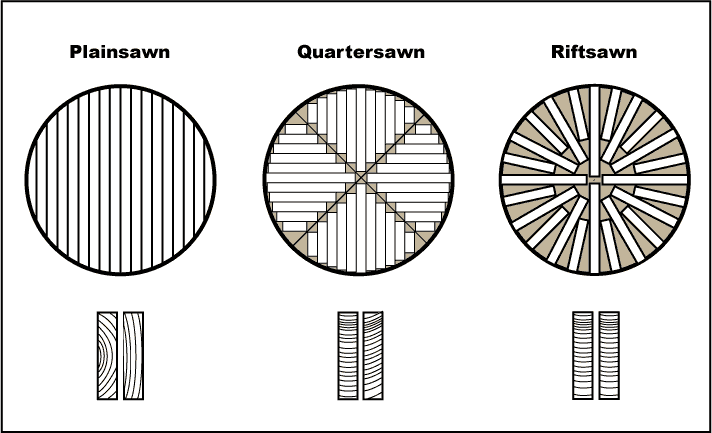There are several different ways to saw trees into usable lumber. Quarter sawn (quartersawn) wood or lumber uses a particular method to mill trees. It yields highly usable, very strong boards with a lot less waste than plain-sawn or rift-sawn lumber. Quartersawn wood is particularly popular for oak and maple. With that lumber, the exposed grain is important and plays a part in its use within a project. Most lumber is made by a process called rip-sawing (plain-sawn lumber). This utilizes almost every square inch of a tree to make usable boards.
What is the Advantage of Quarter Sawn Lumber?
In a nutshell, the advantage of quarter sawn lumber is structural.
The hardiest wood uses a rift-sawn method. That aligns all the boards towards the center of the tree. This generates a grain that crosses the wood and allows it to expand only along its length-side. Quarter-sawing presents a happy medium. It results in a cut that takes more time and energy, but it uses much more of the tree’s available wood. Because it is a more difficult cut, it generates more waste. Therefore, quarter sawn wood generally costs more than plain-sawn material.
How to Identify Quarter Sawn Wood or Boards
Quarter sawn wood or lumber typically has nearly parallel grain lines that cut across the short dimension of the board. This is due to the way the board gets mostly cut against the grain of the tree. Compare that to live sawn wood that ends up with gentle curves of gran across the width of each board.

The Benefits of Quartersawn Lumber
In a word (or two), the benefits of quarter sawn lumber are looks and stability. Because the grain is so consistent on quartersawn lumber, the end product is more stable. The end grain of the wood ends up largely perpendicular to the board’s face. As a result, board twist and “cupping” is reduced.

Ever put down wood on a deck and watch it cup (hopefully downwards? As quartersawn wood dries, the board has less tendency to warp or pull into an odd shape. This is what we mean by the boards being more “stable”.

Now, let’s consider oak or maple. Quartersawn oak was a key feature of the decorative style of the American Arts and Crafts movement, particularly in the early 1900s. Sometimes, the cheaper ash was stained to resemble oak, but it doesn’t show the ray flake inherent in Quartersawn Oak. The rich grain found in oak is inherently pronounced. It has visible ray flecks that become less visible or even disappear when oak is plainsawn.
How Do You Get Quartersawn Wood from a Tree?
So how do you get quarter sawn wood from a tree? Magic! Just kidding. We can’t say absolutely that all mills use the exact same method. However, the name actually seems very appropriate to how the work is performed. Quartersawn wood is literally cut into quarters before it is run through the mill. The “point” is set at the top of the cut. In this way, the wood is sliced with the grain largely perpendicular to the face. The widest lumber is taken from the center of each of the four quarters. It’s a way of aligning the grain into a tighter pattern overall. It also gives the wood its unique, and more consistent, look.
Expansion and Contraction
It’s important to understand how quarter sawn wood, as compared to rip-sawn or plain sawn wood expands and contracts with moisture and humidity. All wood has some movement. Quarter sawn wood has the advantage of putting that movement along the width of the board—not its height. The bigger, and far more beneficial advantage, however, is that quartersawn lumber rarely twists or “cups”. It’s especially suitable for rigid boards, cabinetry, and other uses where that might be unacceptable or challenging.
Why Does It Matter?
Honestly, if you buy your lumber at the local home improvement warehouse—you likely only encounter plain sawn wood. Quarter sawn wood comes from sawmills that specifically cut the boards in that manner. Because the manufacturing process yields less wood than plain sawn methods, the cost goes up. It also takes more effort to cut quarter sawn lumber at the mill. Ultimately, you end up with a more limited supply and only a few sawmills likely produce it in your area.
Have anything to add? Be sure to leave it in the comments below.



